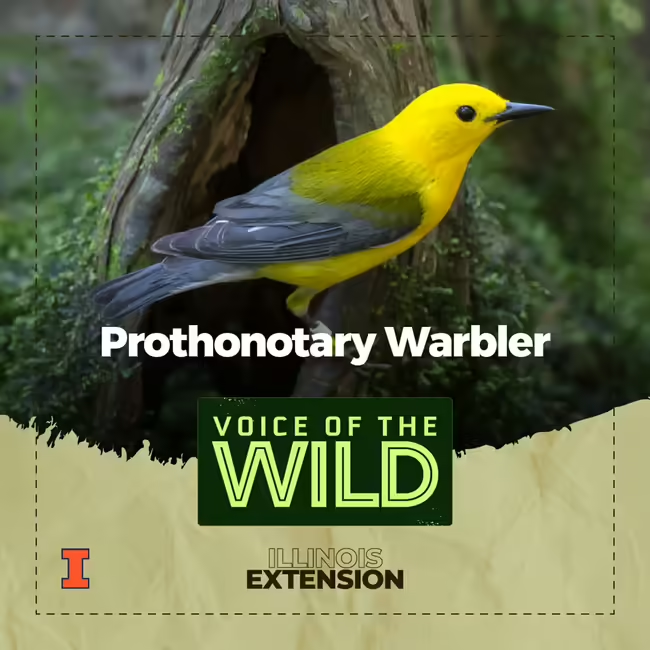
Episode Number
52
Episode Show Notes / Description
Prothonotary warbler (Protonotaria citrea).
A fiery blaze of color and sound.
Do you want to learn more bird songs, frog calls, and insect noises? Join Voice of the Wild every Friday to explore a new wild voice. We’re available on most podcast platforms, including Apple Podcasts, Spotify, and YouTube.
- Subscription links Here
- Subscribe to the Newsletter
- Listen online on our Homepage
The following Cornell Lab | Macaulay Library recordings were used in this episode:
- Prothonotary warbler song by Geoffrey A. Keller (ML508987)
- Prothonotary warbler call by Curtis Marantz (ML508988)
Sources and more:
- https://www.allaboutbirds.org/guide/Prothonotary_Warbler
- https://www.audubon.org/field-guide/bird/prothonotary-warbler
- Dobson C, Kassenbaum D, Oehmke D, et al. 2023. Field guide to hotspots and birds in Illinois. Champaign-Urbana: Scissortail LLC.
- National Audubon Society videoguide to the birds of North America. 2004. Fullscreen. Carrboro, NC: Godfrey-Stadin Productions.
- Peterson RT, Peterson VM. 1980. A field guide to the birds : a completely new guide to all the birds of eastern and central North America. Fourth edition, completely revised and enlarged. Boston: Houghton Mifflin Company (The Peterson field guide series ; 1).
- Sibley D. 2016. Sibley birds East : field guide to birds of eastern North America. Second edition. New York: Alfred A. Knopf (Field guide to birds of eastern North America).
- Stokes DW, Stokes LQ. 2004. Stokes Field Guide to Warblers. 2nd ed. New York: Little, Brown (Stokes field guides).
Transcript
This is Illinois Extension’s Voice of the Wild. A new wild voice in just a moment, so find someplace quiet, take a deep breath, and enjoy.
In this podcast I try to leave most of the poetry and appeals to emotional to the bonus episodes, that’s where I’ve got the time to properly frame the more descriptive language to ensure it is both accurate and relatable.
but Few birds demand a flowery description like this one. Because to describe it as bright yellow with a loud, ringing call, would be precise; but inaccurate. It would fail to capture how so many people perceive this bottomland warbler. So, if you will, please allow me a little leeway; I assure you nothing I say here is a promise that bird wont' keep.
This warbler glows yellow-orange like blown glass taken fresh from a roaring furnace. But unlike glass, it is not still; and though fragile it is not brittle. It moves with an even pace, perceiving - seeing - the world through beady black eyes. Its calls in the spring roll through the swamp like thunder. The bird is a fiery blaze of color and sound and you can almost feel the energy on your face as it flits past on blue-gray wings through the bottomland.
This is the prothonotary warbler (Protonotaria citrea) from the family of the wood warblers, parulidae
I’ve never met an experienced birder who was not fully taken by the prothonotary warbler. Who was not left wanting after it had gone. Never met a birder who was not willing to chase a little. To run or wheel across the park when they hear that one is nearby. It is a marvelous bird. One of the best.
Though they do breed in certain southern Illinois swamps, in tree holes made by woodpeckers typically, they’re more often found during spring migration, almost always low and near water, especially bottomlands, riversides, and flowing stream channels. Here’s the prothonotary warbler again.
Thank you to the Macaulay library at the Cornell lab for our bird sounds. And thank you for tuning in to learn a new wild voice with Illinois Extension.
In this podcast I try to leave most of the poetry and appeals to emotional to the bonus episodes, that’s where I’ve got the time to properly frame the more descriptive language to ensure it is both accurate and relatable.
but Few birds demand a flowery description like this one. Because to describe it as bright yellow with a loud, ringing call, would be precise; but inaccurate. It would fail to capture how so many people perceive this bottomland warbler. So, if you will, please allow me a little leeway; I assure you nothing I say here is a promise that bird wont' keep.
This warbler glows yellow-orange like blown glass taken fresh from a roaring furnace. But unlike glass, it is not still; and though fragile it is not brittle. It moves with an even pace, perceiving - seeing - the world through beady black eyes. Its calls in the spring roll through the swamp like thunder. The bird is a fiery blaze of color and sound and you can almost feel the energy on your face as it flits past on blue-gray wings through the bottomland.
This is the prothonotary warbler (Protonotaria citrea) from the family of the wood warblers, parulidae
I’ve never met an experienced birder who was not fully taken by the prothonotary warbler. Who was not left wanting after it had gone. Never met a birder who was not willing to chase a little. To run or wheel across the park when they hear that one is nearby. It is a marvelous bird. One of the best.
Though they do breed in certain southern Illinois swamps, in tree holes made by woodpeckers typically, they’re more often found during spring migration, almost always low and near water, especially bottomlands, riversides, and flowing stream channels. Here’s the prothonotary warbler again.
Thank you to the Macaulay library at the Cornell lab for our bird sounds. And thank you for tuning in to learn a new wild voice with Illinois Extension.